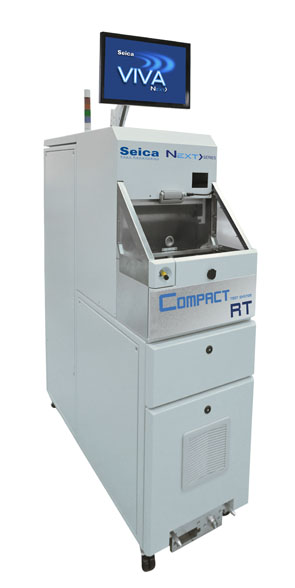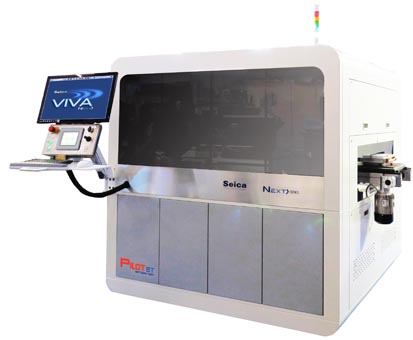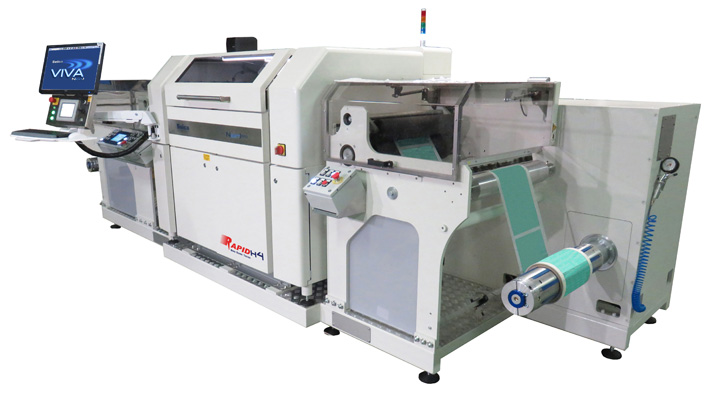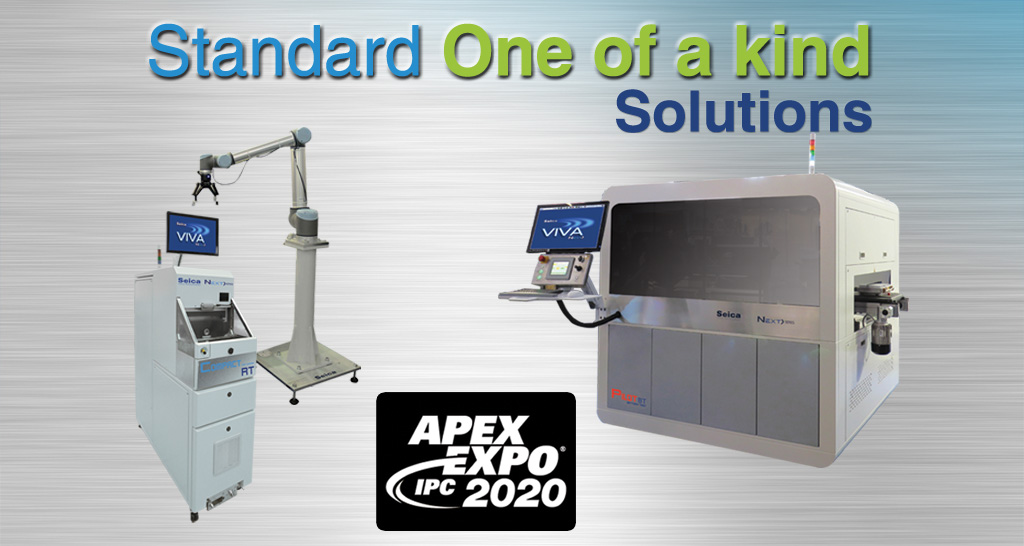February 4-6 – Come and see our latest innovative test and process automation solutions at Apex 2020!
Standard One of a Kind: innovation is truly standard for Seica Inc., and the resulting unique and unusual solutions will be on full display at Apex 2020.
see US-Tech and electronicspecifier
Robotic Process Automation (RPA) is a growing trend in electronic board manufacturing, and the latest board test solution in Seica’s Next Series, the Compact RT, is designed to provide maximum productivity in any RPA scenario: a new, dual-fixture rotary table ensures continuous, optimized test throughput, and its minimal, modular design provides maximum versatility for deployment in different automated handling concepts (robot/cobot) and layouts. Configurable for in-circuit, pre-functional, functional and combinational testing as well as on-board programming, this solution has the modularity needed to provide tailor-made test performance for the specific requirement with all of the advantages of a standard platform. 
Seica continues the “standard one of a kind” concept, made possible by the maximum versatility and configurability of all of the Next Series. In this case the approach is a “distributed test” solution in an automated line which includes Seica Automation handlers linking the Seica Next Series Pilot V8 flying probe tester and Compact SL. The Compact SL is fully automated and, like all of the Seica Next Series Compact line, it is completely configurable for in-circuit, pre-functional, functional and combinational testing, as well as on-board programming. The system architecture conforms to the World Class Manufacturing standard, and is the practical demonstration of how the Seica Compact line integrates the concepts of lean production, maintaining a small footprint without sacrificing performance. If you are looking for a simple, low cost manual ICT or Functional system Seica will have on display our Compact Mini 200 which is easily configurable at the customer site. The system will be shown with a fixture showing multiple-up unit under test (UUT) testing. The Mini line allows the customer to perform more of the custom/integration by their own in-house test departments.
The Pilot V8 is the most extensive flying probe test platform on the market, with up to 20 mobile resources. The standard test probes can each apply up to 2A current and the system can be configured with high-resolution cameras for automatic optical inspection, barcode and data matrix reading, laser sensors, capacitive probes, pyrometers, optical fiber sensors for LEDs, mini-fixtures for boundary scan and On Board Programming. Shown in its fully-automated version, compatible with any standard assembly line, the Pilot V8 Next is engineered for medium/high volume production, and can be configured to satisfy the full range of different board test requirements. Other available features include the High Resolution (HR) option, which extends the performance to probing of extremely miniaturized devices (down to 30 µm), and the High Frequency (HF) option with high-frequency probes, able to measure signals at frequencies over 1.5 GHz. The Pilot V8 XL version expands the standard work area of 610 x 540 mm to 800 x 650 mm, to accommodate and test “extra-large” boards often seen in panel arrays, and probe cards used in the semiconductor industry.

The rapid expansion of the electric vehicle market requires new solutions to address rising manufacturing demand, and specifically for one of the key components: batteries. Seica has a developed a new solution for EV battery test, the Pilot BT, which was initially shown at Productronica in November 2019 and now premiering at Apex for the first time! This new addition to the Seica Pilot Next Series, represents a new generation of flying probe test solutions for the specific test requirements of this increasingly high-volume manufacturing process. In the maximum configuration of four flying heads, the new, innovative hardware architecture of the Seica Pilot BT is able to perform parallel, very precise Kelvin tests of 16 cells at once, achieving production rates of nearly 2400 battery cells per minute, more than doubling first generation performance. In addition to test throughput, configurability and flexibility are key: the Seica Pilot BT utilizes “flying connectors”, that can be arranged from 2 to 16 channels in either an X or Y axis orientation, that are easy to change as required to accommodate different battery configurations as they come through production. Manufacturers also need the option to handle products of various dimensions: the Seica Pilot BT can test battery packs up to 1050 x 865 mm (41.33 x 34.05 inches) and weighing over 100 kilograms.
The DRAGONFLY Next > provides optical inspection of THT components: the combination of multi-colored LED lighting and color scan camera enables detailed inspection of the solder joint meniscus and shorts detection, while the full scan acquisition of the PCB surface and not only of the components allows the detection of solder balls. The DRAGONFLY Next > series also includes the configuration for conformal coating inspection of finished products, as well as for process control and setup. Configurable for single and double sided inspection of the board, its intuitive and streamlined management software environment enables the user to develop and deploy an application program in a few hours. On display will be the desktop version of the Dragonfly with the dual hybrid capability. The desktop version is a modular unit that can be used for sample and low volume testing.

Also of keen interest will be the Rapid H4 Flex flying probe test solution: deployed in Seica’s Virtual Factory (VR), visitors will be able to have a hands-experience with this solution in a realistic manufacturing environment. Nominated for the Productronica Innovation Award 2019, the Rapid H4 Flex addresses the needs of flexible PCB manufacturers that wish to test their circuits in a continuous reel format. The test system features 4 completely independent mobile test probes, and the ample test area is equipped with a vacuum table to hold in place the flexible circuit under test. In addition to the full range of standard test performances, Seica’s proprietary, high-resolution capacitive one-touch-per-net technique is able to measure the capacitance of each track/pad to detect short and open circuits, and the included standard, four-wire Kelvin techniques. This fully integrated solution includes the specifically designed, automated handling modules which enable a completely reel-to-reel process. This new system was released in 2019 and will be shown for the first time in North America in our VR factory.
All of the solutions on display include Seica’s VIVA NEXT software platform, which is able to provide intelligent integration with all aspects of the customer’s manufacturing processes – data collection, traceability, interaction with MES, repair operations – and all of the Next> series systems have Canavisia’s Industrial Monitoring solution on board, for remote monitoring of current and voltage consumption, mains supply, temperature, light indicators and other parameters useful to indicate correct operation, provide information for predictive maintenance and, in general, to render the systems compatible with today’s Industry 4.0 standards.
Tags: EV battery Test, Rotary table


